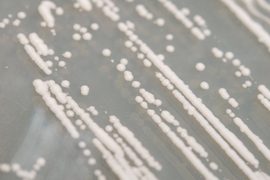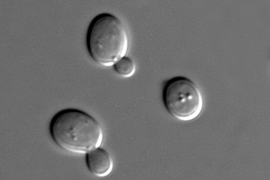Biophysics research has a champion in Jeff Gore, the Latham Family Career Development Assistant Professor of Physics, who led the opening of the Physics of Living Systems group at MIT in April, and whose lab has explored the dynamics of population growth and collapse in yeast.
In a recently published paper, Gore and co-authors suggest lessons from their population dynamics work can be applied to cancer growth by thinking of cancer as an endangered species. Evidence from natural population extinctions, as well as theoretical and empirical studies, point to new ways of guiding drug delivery by identifying the threshold population for cancer cells to form a tumor. Lead author of that paper is Kirill Korolev, an assistant professor of physics at Boston University, who previously served as a Pappalardo Postdoctoral Fellow at MIT.
Gore and Lei Dai, a graduate student in Gore's lab, are also applying the analytical tools honed on the yeast research in collaborations with researchers studying populations outside of the lab. For example, they are collaborating in a study of honeybee colonies with Christina Grozinger, a professor of entomology and director of the Center for Pollinator Research at Penn State College of Agricultural Sciences. Preliminary findings show similar population dynamics, where honeybee colonies require a minimal size for survival. The new work builds on research establishing early warning signals for population collapse in colonies of the yeast, Saccharomyces cerevisiae. Dai was the lead author on two papers establishing the theoretical and experimental findings in the yeast. Gore and Dai also collaborate with Lisandro Benedetti-Cecchi, an associate professor in ecology at the University of Pisa, Italy, who is a field ecologist studying algael mats on the coast of Mediterranean islands.
Gore is the driving force behind the new Physics of Living Systems group, which brings together Gore and MIT colleagues, Jeremy L. England, an assistant professor of physics, and Alfredo Alexander-Katz, the Walter Henry Gale Associate Professor of Materials Science and Engineering. A fourth member, Nikta Fakhri, is expected to join soon.
"Jeff Gore has pushed this project of trying to have a nucleus of people interested in the physics of what we call living systems. It's truly like a biophysics cluster. Biophysics actually happens at many places in the Institute, but always having people together in close proximity is very useful for collaborations and so forth," Alexander-Katz says.
"The idea is that we'd really like to bring together the theorists and the experimentalists because there is very much something that we have in common regardless of whether we're studying biological phenomena at the molecular, cellular, or population scale," Gore says.
Yeast and honeybees are similarly cooperative populations, meaning the success of the group is dependent on the cooperation of individuals. When an organism that thrives at an intermediate population size fails because that population grows too small, that is called an Allee effect. Positive interactions between the members of the population can lead to these threshold effects in which there is a minimal viable population size.
"When a population has these positive interactions, these positive feedback loops, then it can display these sudden transitions, these tipping points leading to collapse. Our experimental work is half dedicated to how microbial populations behave and half dedicated to try to understand phenomena that may transcend the microbial populations but that may be relevant for zebra populations or fisheries or honeybee colonies, or maybe for a population of cancer cells that have these sort of positive interactions," Gore explains.
The laboratory has also worked to extend these ideas to populations with genetic heterogeneity. In work with postdoc associate Alvaro Sanchez, now a junior fellow at the Rowland Institute of Science at Harvard University, the lab demonstrated that a mixed population of cooperators and cheaters in yeast responded to stress by altering the mix of cooperators and cheaters. Given sufficient time, the population evolved to reach a new stable state, but a sudden stress caused the population to collapse.
"In some ways we're using these yeast populations to get insight into phenomena that we think may be similar across many different kinds of populations," he says. Gore's research is partially managed by the Materials Processing Center.
The Gore lab is also exploring how these sudden transitions may be relevant to cellular decision making — for example, in deciding whether to consume sugar A or sugar B. "One of the things we've been studying are these sorts of transitions between states and how you can get sudden transitions in response to small changes in the environment. There is a nice analogy between how that happens for populations and ecosystems and how this happens in cellular decision making," Gore says. "One of the things that we've demonstrated recently is there is a loss of resilience to perturbations as you get close to one of these transition points. This is a general phenomenon, this loss of resilience that we had explored in the context of populations, and now we've demonstrated that there is a similar phenomenon at play in the context of cellular decision making."











